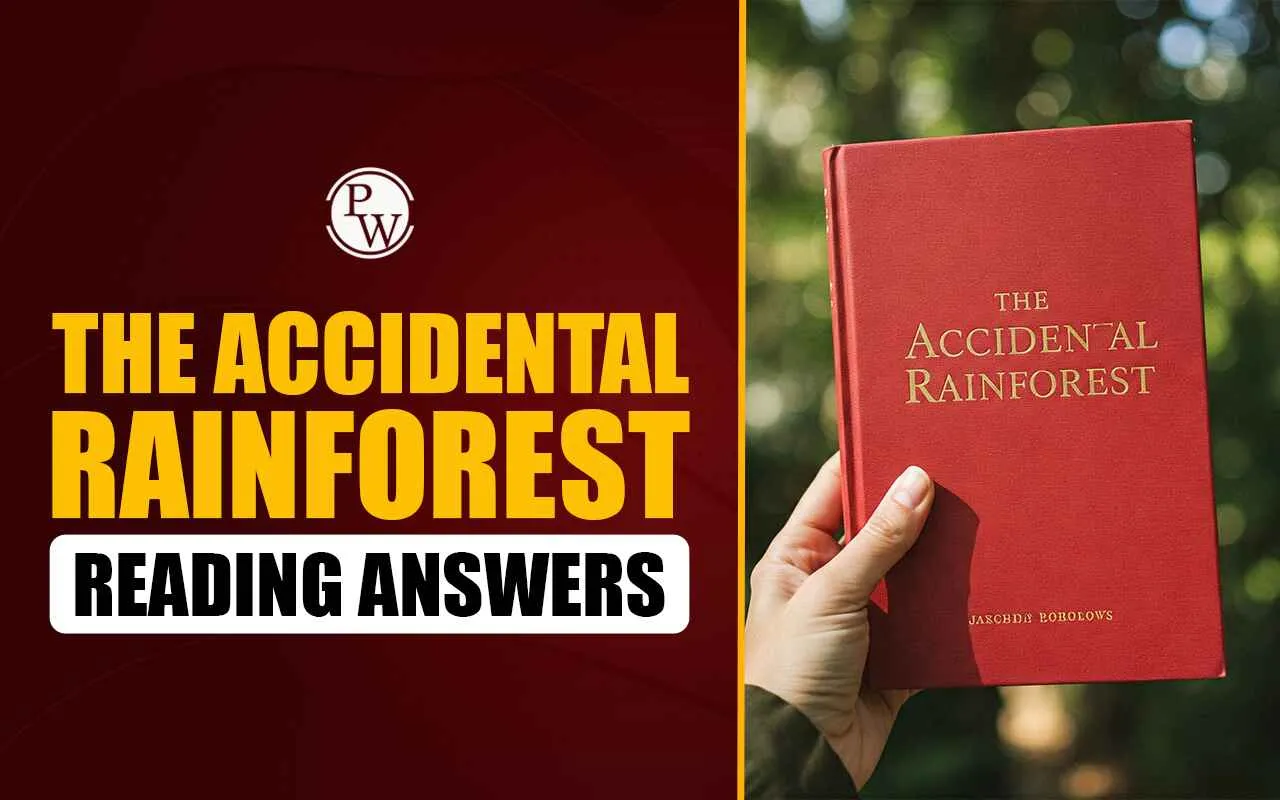

The Accidental Rainforest Reading Answers: The Accidental Rainforest is an IELTS Academic Reading passage that examines how the barren volcanic island of Ascension was unintentionally transformed into a thriving tropical rainforest. This article is useful for IELTS test-takers aiming to improve their ability to identify factual information, understand opinion-based questions, and follow the writer’s argument. The passage challenges conventional ecological theories and presents an unusual case of human-made ecosystem development. Practising with this IELTS Reading passage will help you sharpen your skills in TRUE/FALSE/NOT GIVEN, Matching Information, and Multiple Choice questions.
The Accidental Rainforest Reading Answers Passage
The Accidental Rainforest
According to ecological theory, rainforests are supposed to develop slowly over millions of years. But now ecologists are being forced to reconsider their ideas.
A. When Peter Osbeck. a Swedish priest, stopped off at the mid-Atlantic island of Ascension in 1752 on his way home from China, he wrote of ‘a heap of ruinous rocks’ with a bare, white mountain in the middle. All it boasted was a couple of dozen species of plant, most of them ferns and some of them unique to the island.
B. And so it might have remained. But in 1843 British plant collector Joseph Hooker made a brief call on his return from Antarctica. Surveying the bare earth, he concluded that the island had suffered some natural calamity that had denuded it of vegetation and triggered a decline in rainfall that was turning the place into a desert. The British Navy, which by then maintained a garrison on the island, was keen to improve the place and asked Hooker’s advice. He suggested an ambitious scheme for planting trees and shrubs that would revive rainfall and stimulate a wider ecological recovery. And, perhaps lacking anything else to do, the sailors set to with a will.
C. In 1845, a naval transport ship from Argentina delivered a batch of seedlings. In the following years, more than 200 species of plant arrived from South Africa, from England came 700 packets of seeds, including those of two species that especially liked the place: bamboo and prickly pear. With sailors planting several thousand trees a year, the bare white mountain was soon cloaked in green and renamed Green Mountain, and by the early twentieth century the mountain’s slopes were covered with a variety of trees and shrubs from all over the world.
D. Modern ecologists throw up their hands in horror at what they see as Hookers environmental anarchy. The exotic species wrecked the indigenous ecosystem, squeezing out the island’s endemic plants. In fact. Hooker knew well enough what might happen. However, he saw greater benefit in improving rainfall and encouraging more prolific vegetation on the island.
E. But there is a much deeper issue here than the relative benefits of sparse endemic species versus luxuriant imported ones. And as botanist David Wilkinson of Liverpool John Moores University in the UK pointed out after a recent visit to the island, it goes to the heart of some of the most dearly held tenets of ecology. Conservationists’ understandable concern for the fate of Ascension’s handful of unique species has, he says, blinded them to something quite astonishing the fact that the introduced species have been a roaring success.
F. Today’s Green Mountain, says Wilkinson, is ‘a fully functioning man-made tropical cloud forest’ that has grown from scratch from a ragbag of species collected more or less at random from all over the planet. But how could it have happened? Conventional ecological theory says that complex ecosystems such as cloud forests can emerge only through evolutionary processes in which each organism develops in concert with others to fill particular niches. Plants eo-evolve with their pollinators and seed dispersers, while microbes in the soil evolve to deal with the leaf litter.
G. But that’s not what happened on Green Mountain. And the experience suggests that perhaps natural rainforests are constructed far more by chance than by evolution. Species, say some ecologists, don’t so much evolve to create ecosystems as make the best of what they have. ‘The Green Mountain system is a man-made system that has produced a tropical rainforest without any co-evolution between its constituent species,’ says Wilkinson.
H. Not everyone agrees. Alan Gray, an ecologist at the University of Edinburgh in the UK. argues that the surviving endemic species on Green Mountain, though small in number, may still form the framework of the new ecosystem. The new arrivals may just be an adornment, with little structural importance for the ecosystem.
I. But to Wilkinson this sounds like clutching at straws. And the idea of the instant formation of rainforests sounds increasingly plausible as research reveals that supposedly pristine tropical rainforests from the Amazon to south-east Asia may in places be little more titan the overgrown gardens of past rainforest civilisations.
J. The most surprising thing of all is that no ecologists have thought to conduct proper research into this human-made rainforest ecosystem. A survey of the island’s flora conducted six years ago by the University of Edinburgh was concerned only with endemic species. They characterised everything else as a threat. And the Ascension authorities are currently turning Green Mountain into a national park where introduced species, at least the invasive ones, are earmarked for culling rather than conservation.
K. Conservationists have understandable concerns, Wilkinson says. At least four endemic species have gone extinct on Ascension since the exotics started arriving. But in their urgency to protect endemics, ecologists are missing out on the study of a great enigma.
L. As you walk through the forest, you see lots of leaves that have had chunks taken out of them by various insects. There are caterpillars and beetles around.’ says Wilkinson. ‘But where did they come from? Are they endemic or alien? If alien, did they come with the plant on which they feed or discover it on arrival?’ Such questions go to the heart of how- rainforests happen.
| IELTS Exam Important Links | |
|---|---|
| IELTS Reading Band Score | IELTS Listening Band Score |
| IELTS Speaking Band Score | IELTS Writing Band Score |
The Accidental Rainforest Reading Answers Sample Questions
Questions 1–5
Do the following statements agree with the information given in the Reading Passage?
Write:
-
TRUE if the statement agrees with the information
-
FALSE if the statement contradicts the information
-
NOT GIVEN if there is no information on this
-
Ascension Island originally had a large variety of plant life.
-
Joseph Hooker believed planting trees could increase rainfall.
-
Plants introduced to Ascension came only from South Africa and England.
-
Bamboo and prickly pear were among the species that thrived.
-
Hooker was unaware of the ecological risks of introducing foreign species.
Questions 6–10
Choose the correct letter, A, B, C, or D.
Write your answers in boxes 6–10 on your answer sheet.
-
What was Joseph Hooker’s role on Ascension Island?
A. He studied native plants.
B. He designed a plan to restore vegetation.
C. He built a botanical garden.
D. He lived on the island as a researcher. -
What is David Wilkinson’s view on the forest on Green Mountain?
A. It is harmful to native species.
B. It lacks structure and balance.
C. It contradicts established ecological theory.
D. It should be replaced with endemic plants. -
According to the passage, how do some ecologists explain the formation of ecosystems?
A. Through rapid adaptation of species
B. Through random planting
C. Through co-evolution over time
D. Through climate control and irrigation -
What is Alan Gray’s opinion about Green Mountain’s ecosystem?
A. The new species are more useful than the old ones.
B. Endemic species still form the ecosystem’s core.
C. The ecosystem should be removed completely.
D. Evolution is no longer relevant to ecosystem study. -
What does Wilkinson suggest about other tropical forests like the Amazon?
A. They may not be entirely natural.
B. They contain only native plants.
C. They are shrinking rapidly.
D. They evolved from one species.
Questions 11–14
Match each statement with the correct paragraph (A–L).
Write the correct letter A–L in boxes 11–14.
-
A researcher questions the origin of the insects living in the forest.
-
A survey focused only on the island’s original species.
-
The British Navy became involved in the planting project.
-
Some scientists believe the new forest was accidentally successful.
The Accidental Rainforest Reading Answers with Explanations
Answers to Questions 1-14
|
Question |
Answer |
Explanation |
|---|---|---|
|
1 |
FALSE |
Para A: The island had only a few plant species, mostly ferns. |
|
2 |
TRUE |
Para B: Hooker suggested planting to increase rainfall. |
|
3 |
FALSE |
Para C: Plants came from Argentina, South Africa, and England. |
|
4 |
TRUE |
Para C: Bamboo and prickly pear were mentioned as thriving species. |
|
5 |
FALSE |
Para D: Hooker was aware of the risks but chose to go ahead. |
|
6 |
B |
Para B: Hooker suggested a planting scheme to restore rainfall. |
|
7 |
C |
Para F–G: Wilkinson believes the forest contradicts ecological theory. |
|
8 |
C |
Para F: Traditional theory says ecosystems evolve over time via co-evolution. |
|
9 |
B |
Para H: Gray believes endemic species still form the framework. |
|
10 |
A |
Para I: Wilkinson mentions some rainforests may be overgrown gardens of past civilizations. |
|
11 |
L |
Wilkinson wonders about the insects and whether they are endemic or alien. |
|
12 |
J |
A University of Edinburgh survey focused only on endemic species. |
|
13 |
B |
The British Navy helped with the planting, based on Hooker’s plan. |
|
14 |
E |
Wilkinson challenges traditional ideas, saying the random species were highly successful. |
Also Read:
- Should You Use All Capital Letters in the IELTS Listening and Reading Tests
- IELTS Reading Mistakes
- How to Improve IELTS Reading Score
- How to Manage Time in IELTS Reading
Guidance of PW IELTS
Physics Wallah offers multiple online IELTS courses for all students. Follow the IELTS pages to better prepare for the exam.
| What is IELTS Exam? | Documents Required for IELTS Registration |
| IELTS exam eligibility requirements | IELTS Exam Fees |
| IELTS test results | IELTS Exam Pattern |
The Accidental Rainforest Reading Answers FAQs
What is the main idea of The Accidental Rainforest passage?
Who was Joseph Hooker and what role did he play?
Why is Green Mountain considered unique by ecologists?
What criticism do conservationists have about the introduced species?
What is David Wilkinsons main argument?













